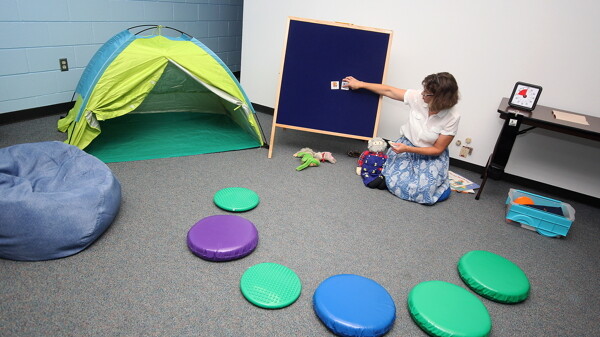Across the Spectrum
local libraries gearing special programs towards autism spectrum disorders
Kinzy Janssen, photos by Andrea Paulseth

Twenty libraries throughout the region are taking advantage of a grant that will help address the needs of local children who fall along the autism spectrum. Leah Langby, Library Development and Youth Services Coordinator for the Indianhead Federated Library System, applied for the grant, which awarded a total of $19,475 to participating libraries for programming and materials designed to make public libraries feel more welcoming for kids with ASD (autism spectrum disorder) and their families.
ASD refers to autistic disorder, Asperger syndrome, and pervasive developmental disorder – not otherwise specified (PDD-NOS), but the metaphor of a spectrum connotes how the disorders “differ in terms of when the symptoms start, how severe they are, and the exact nature of the symptoms,” according to the Centers for Disease Control and Prevention.
“I’d rather not limit it … I want them to commingle, and for parents to get to know each other and to know that we have a judgment free zone here.” – Jenna Gilles, Youth Program Coordinator, Fall Creek Public Library
“We know a couple of families that have kids in the spectrum and that number just keeps going up. So it’s hard to ignore,” says Langby. According to the CDC, which surveyed children born in 2000, “one in 88 children has been identified with an autism spectrum disorder.” When compared with children born in 1992 and even 1994, the contrast in prevalence is staggering – only one in 150 were diagnosed with ASD then. Though the cause is still a bit cloudy, with some pointing to various mutations in genes and others saying environmental factors play a role, the national statistics are playing out on a local level.
So far, however, Crowley says attendance at “Little Rainbows Sensory Storytime” has been light. But the families who have participated (or plan to) are grateful for the atmosphere of acceptance and understanding. The storytimes themselves, geared toward children whose developmental age falls between three and six, retain the basic elements of other storytimes (15-20 minutes worth of stories followed by semi-structured activities and social playtime), but with a few tweaks.
“The kids have more sensory input options, more fidgety things,” says Langby, mentioning that colorful scarves will be available for restless hands.
Jenna Gilles, Youth Program Coordinator for Fall Creek Public Library, is gearing up for the first installment of their “Spectrum Nights” storytime series on Sept. 25. Though she’s worked with children on the spectrum before, this is the first storytime designed specifically for that segment.
“In these sessions there’s going to be more of ‘touch, feel, see, hear’… all the senses will be included,” she says. “And we’re going to focus less on sitting and more on being enveloped in the story.” Some sensory details are carefully controlled beforehand, including the music. The accompanying music for a typical storytime session is “upbeat, loud, and bouncy,” according to Gilles. “Storytimes for children on the autism spectrum will be more of a calming experience,” she says. “The music will be mellow and more flowing. Louder music can startle some children on the spectrum.”
At the Chippewa Falls Public Library, one of the things Children’s Services Coordinator Colleen Crowley decided to change right away was the look and feel of the story room.
“It was cluttered. So they took down the photos and painted it a light blue – the color recommended to be most inviting to children on the spectrum. They got curtains and light filters, so it’s less intense and less troubling,” says Langby, explaining that any outing can be a challenge for families dealing with ASD.
Gilles says any and all children are welcome to attend the new format (though they’re still offering their standard format), as long as they sign up in advance.
“I’d rather not limit it … I want them to commingle, and for parents to get to know each other and to know that we have a judgment free zone here,” she says.
Though continuation of programming in 2013 is uncertain and up to the independent libraries themselves, Langby says that’s the goal. She’s applying for the same grant for next year but plans to focus on welcoming adults and teens on the spectrum.

